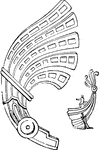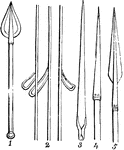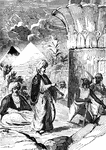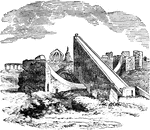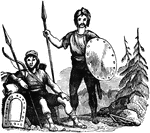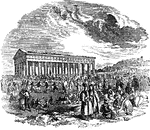
Cestus
"The cestus used in later times, in the public games, was a most formidable weapon. It was frequently…
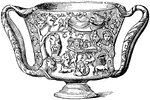
Carchesium
"The carchesium was a beaker, or drinking-cup, which was used by the Greeks in very early times. It…
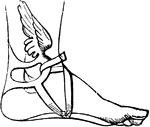
Talaria
"Talaria, small wings fixed to the ankles of Mercury, and reckoned among his attributes. In many works…
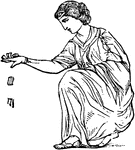
Talus
"Talus. The huckle-bones of sheep and goats were used to play with from the earliest times, principally…
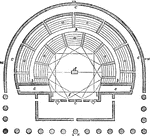
Theatrum
"Theatrum, a theatre. The Athenians before the time of Aeschylus had only a wooden scaffolding on which…
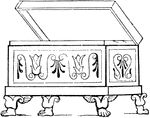
Ancient censer
"In makin Aeneas burn incense, Virgil follows the custom of his own time rather than historical verity."…
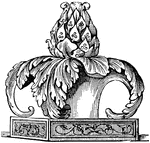
Thyrsus
"Thyrsus, a pole carried by Bacchus, and by Satyrs, Maenades, and others who engaged in Bacchic festivities…
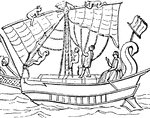
Greek Boat
"The masts were usually taken down when the vessel arrived in port, and raised again when it was about…
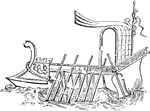
Ship with rudder
"The following cut represents a ship with its rudder. The pole by which it is fastened to the ship's…

Litmus
"This instrument was long, and curved at the end. From the similarity of form the original staff received…
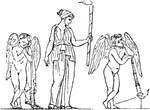
Torches
"On ancient monuments, the torch appears to be formed of wooden staves or twigs, either bound by a rope…
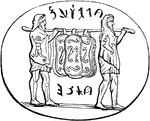
Ancilia
"According to the ancient authorities, it was made of bronze, and its form was oval, but with the two…
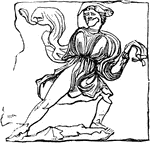
Tunica
"Tunica, an under-garment. Greek. The chiton was the only kind of under-garment, worn by the Greeks.…

Tunica
"Tunica, an under-garment. Greek. The chiton was the only kind of under-garment, worn by the Greeks.…

Tunica
"Tunica, an under-garment. Greek. The chiton was the only kind of under-garment, worn by the Greeks.…

Curved buccina
"The buccina is curved for the convenience of the performer, with a very wide mouth, to diffuse…

Turibulum
"Turibulum, a censer. The Greeks and Romans, when they sacrificed, commonly took a little frankincense…
Straight buccina
"A copy of an ancient sculpture taken from Blanchini's work, it still retains the original form of the…

Greaves and shield
"Represents the interior view of a bronze shield and a pair of greaves. These greaves are made right…
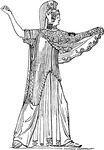
Minerva with aegis
"According to ancient mythology, the aegis worn by Jupiter was the hide of the goat Amalthea, which…

Aegis
"A breastplate covered with metal in the form of scales, not used to support the shield, as was done…

George I, King of Greece
George I (born Prince William of Schleswig-Holstein-Sonderburg-Glücksburg; 24 December 1845 – 18…
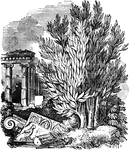
Ancient Persia
"Ancient Persia was among the great empires that figure in the early history of mankind. Little of their…
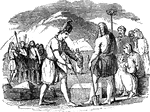
Founding of Argos
"Navigation for the purpose of commerce, and the art of writing, are said to have originated with the…
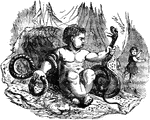
Young Hercules
"Hercules, a Theban prince, was another of the descendants of Pelops. The numerous and extraordinary…
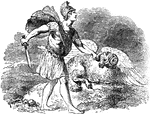
Phryxsus and ram
"When Phryxsus arrived in Colchis, he sacrificed his winger ram to Jupiter, in acknowledgement of the…
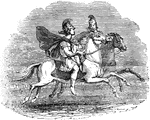
Theseus and Helen
"In the year 1234 B.C., Theseus came to the throne of Athens. He was one of the most renowned characters…
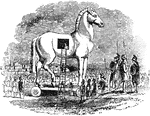
Trojan horse
"According to the poets, it was by stratagem that this famous city was at last overcome. They tell us…
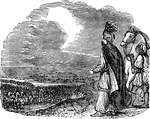
Xerxes surveying his army
"About the year 480 B.C., Xerxes, an Asiatic king, assailed the country with an army of several millions.…
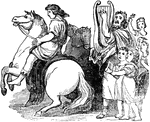
Victors at the Olympic Games
"From a very remote period, the Greeks had been accustomed to engage in contests of strength and agility…
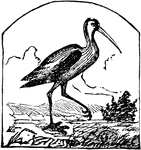
Ibis
A genus of wading birds, one species of which was regarded in ancient Egypt with a degree of respect…

Greek
"The Greeks belong to the great Indo-European race, who from the earliest times have been the conquerers…
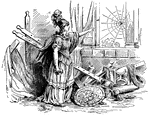
Minerva
"On Minerva's side Varro tells us that Cecrops found an olive tree and a fountain, and that on consulting…

The Dioscuri
"Castor and Pollux were the offspring of Leda and the Swan, under which disguise Jupiter had concealed…

Sylvanus
"Sylvanus and Faunus were Latin divinities, whose characteristics are so nearly the same as Pan that…
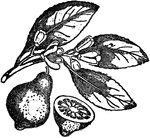
Lemon
The fruid of the tropical or subtropical tree citrus medica, of the orange family, and originally native…

Miltiades
Celebrated general of Athens, born in the latter part of the 6th century B.C. His skill and bravery…
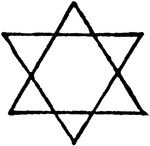
Star Designs
An emblem seen the world over in decoration, especially in synagogues. It is common in the Caucasian…

